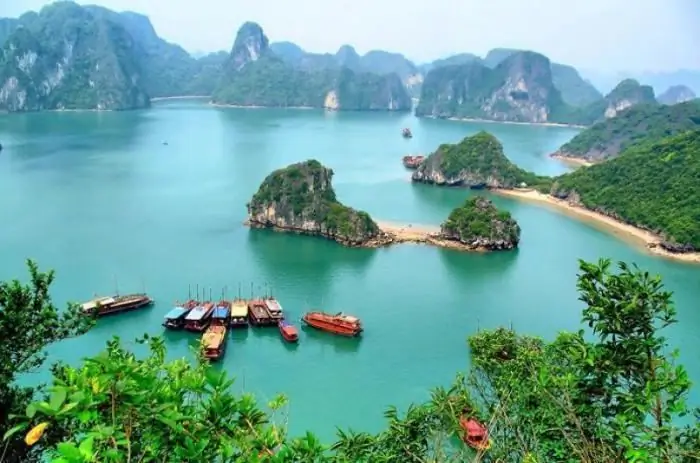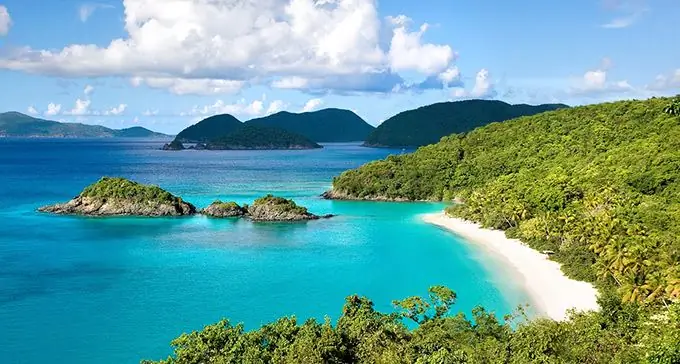- Author Harold Hamphrey [email protected].
- Public 2023-12-17 10:06.
- Last modified 2025-01-24 11:10.
To the north of Ho Chi Minh City, at a distance of two hundred kilometers, is the city of Phan Thiet (the center of Binh Thuan Province). The road along the coast of the South China Sea, leading from it in a northeasterly direction, climbs a hill with Champ towers on top and then descends to Mui Ne, a crescent-shaped bay lined with beautiful sandy beaches. Not so long ago, this place was just a coconut grove with a few fishing huts along the beaches, but in the last little less than twenty years there have been major changes here, and today it is adorned with a fifteen-kilometer resort strip with restaurants, bars, hotels, sparkling like pearls in the shade of palm trees. trees along the main street - Nguyen Dinh Hieu.

When it comes to plans to vacation in some tropical corner, the choice often falls on Vietnam lately. Mui Ne Beach, the area between Phan Thiet and the fishing village of Mui Ne, is considered one of the most popular resorts in the country, yielding quite a bit to Nha Trang. With a well-developed infrastructure, it is especially loved by vacationers from European countries (Germany, Austria) and Russia.
The etymology of its name is interesting. In the past, when fishermen got caught in storms, they waited out on a cape (mui in Vietnamese). The second part of the word "not" means "to hide" (to hide). Hence the name Mui Ne.
Vietnam has been developing as a major tourism hub since the 1990s, supported by significant public and private investment, especially in coastal areas. Ten cities are the main destinations on the country's tourist map: Hanoi, Ho Chi Minh City, Hai Phong, Da Nang, Can Tho, Hue, Da Lat, Vung Tau, Nha Trang and Phan Thiet/Mui Ne, which has recently been very often referred to as the resort capital of Vietnam.
Due to strong breezes between November and March, Mui Ne is well known and popular among kitesurfers and windsurfers. The picturesque combination of mountain scenery and beautiful beaches, as well as famous landmarks of the Champa culture, attract both local tourists and foreign travelers. Ka Na Beach, stretching for several kilometers of blue-blue sky and turquoise sea surface, bright sun and golden sand, known for its fantastic coral reefs, is a two-hour drive from Mui Ne. Vietnam offers amazing scuba diving opportunities in this part of the country.

It is also called the golden sand desert due to the orange dunes that serve as an inspiration for manyphotographers for many years. Flying sand dunes, located ten kilometers from the main resort area, near the fishing village, are so named because, due to the influence of the wind, they tend to constantly change shapes and colors (to reddish, white, pink, whitish-gray, reddish-gray and so on).
Suoi Thien or "fairy stream" is a shallow river with a small waterfall that flows through a sandy canyon that resembles a mini version of the Grand Canyon, through a bamboo grove. In the vicinity you can see many local representatives of flora and fauna (birds, crabs, fish, frogs, exotic plants). Next to Fairy Creek is a fish sauce factory (Nuoc Nam), for which Phan Thiet/Mui Ne is famous.
Vietnam in this area has a lot to offer for lovers of good cuisine. An incredible abundance of fresh vegetables, fruits, herbs, fish and seafood, which are used to prepare wonderful dishes, including nuok nam, in local restaurants surrounding each resort.
In the restaurant "Java", which is located along Nguyen Dinh Hieu on a hill just above Phan Thiet, an interesting innovation has recently appeared. Deaf children create beautiful sand paintings. On the territory of the restaurant there is also a handmade fabric shop with traditional cham motifs. The shop employs a tailor who immediately transforms materials into beautiful clothes at very competitive prices.
However, many restaurants have shops offering exotic gifts and souvenirs: jewelry, local fabrics,handbags and other accessories made of crocodile skin, ceramics, beachwear.
There are a number of excellent markets in the area. In Phan Thiet, the central market is considered the largest in the province. Here you can buy many traditional products, fresh fruits, coconut candies, dried seafood, sand paintings. Don't forget to visit the market and fishing harbor in the village of Mui Ne, located in the north of the bay.

On Ong Hoang hill you can see the complex of Champa towers built in the eighth century. Every year, on the first of October (on the first day of July according to the Champ calendar), a traditional festival is held on the territory of the complex, during which residents thank their ancestors and pray for good luck and good harvests throughout the country, not only in Mui Ne.
Vietnam is undoubtedly a very beautiful country, inviting travelers of all categories: nature lovers, beach lovers, those who are interested in ancient cultures. Most of them, visiting the country for the first time, are surprised by the amazing untouched landscapes, ancient history and diverse culture, unique historical monuments, temples and museums. They bring unforgettable impressions from their travels and promise themselves to return to this peaceful and beautiful land. And if the question arises about what else Vietnam can surprise travelers with, Mui Ne (reviews of which are always filled with joyful and emotional delights) will be the right answer!






